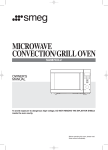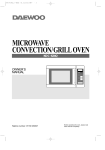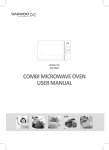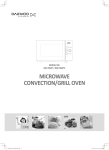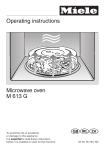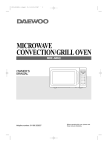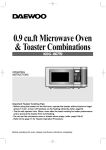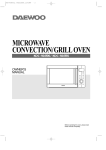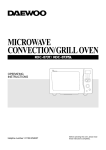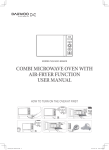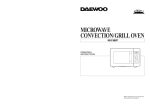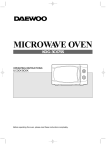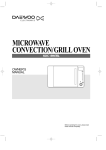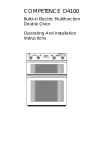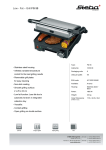Download Daewoo Electronics KOG-8755 User's Manual
Transcript
MICROWAVE/GRILL OVEN KOG-8755 OPERATING INSTRUCTIONS Power Timer 0 1 2 60 3 50 4 40 5 6 30 20 10 9 8 7 Before operating this oven, please read these instructions completely. PRECAUTIONS TO AVOID POSSIBLE EXPOSURE TO EXCESSIVE MICROWAVE ENERGY (a) Do not attempt to operate this oven with the door open since open-door operation can result in harmful exposure to microwave energy. It is important not to defeat or tamper with the safety interlocks. (b) Do not place any object between the oven front face and the door or allow soil or cleaner residue to accumulate on sealing surfaces. (c) WARNING : If the door or door seals are damaged, the oven must not be operated until it has been repaired by a trained person : (1) door (bent), (2) hinges and latches(broken or loosened), (3) door seals and sealing surfaces. (d) WARNING : It is hazardous for anyone other than a trained person to carry out any service or repair operation which involves the removal of any cover which gives protection against exposure to microwave energy. (e) WARNING : Liquids or other foods must not be heated in sealed containers since they are liable to explode. (f) WARNING : Only allow children to use the oven without supervision when adequate instructions have been given so that the child is able to use the oven in a safe way and understands the hazards of improper use. TABLE OF CONTENTS PRECAUTIONS TO AVOID POSSIBLE EXPOSURE TO EXCESSIVE MICROWAVE ENERGY 1 TABLE OF CONTENTS 1 IMPORTANT SAFETY INSTRUCTIONS EARTHING INSTRUCTIONS 2 4 INSTALLATION 4 SPECIFICATIONS 5 ACCESSORIES 6 CONTROL PANEL 7 HOW TO SET THE OVEN CONTROLS 1 8 KEEP THE OVEN CLEAN 11 BEFORE CALLING FOR SERVICE 12 QUESTIONS AND ANSWERS 13 IMPORTANT SAFETY INSTRUCTIONS WARNING : To prevent fire, burns, electric shock and other warnings: Listed below are, as with all appliances, certain rules to follow and safeguards to assure high performance from this oven: 1. Do not use the oven for any reason other than food preparation, such as for drying clothes, paper, or any other nonfood items or for sterilizing purposes. 2. Do not use the oven when empty, this could damage the oven. 3. Do not use the oven cavity for any type of storage, such as papers, cookbook, cookware, etc. 4. Do not operate the oven without the glass tray in place. Be sure it is properly sitting on the rotating base. 5. Make sure you remove caps or lids prior to cooking when you cook food sealed in bottles. 6. Do not put foreign material between the oven surface and door. It could result in excessive leakage of microwave energy. 7. Do not use recycled paper products for cooking. They may contain impurities which could cause sparks and/or fires when used during cooking. 8. Do not pop popcorn unless popped in a microwave approved popcorn popper or unless it's commercially packaged and recommended especially for microwave ovens. Microwave popped corn produces a lower yield than conventional popping; there will be a number of unpopped kernels. Do not use oil unless specified by the manufacturer. 9. Do not cook any food surrounded by a membrane, such as egg yolks, potatoes, chicken livers, etc., without first piercing them several times with a fork. 10. Do not pop popcorn longer than the manufacturer's directions. (popping time is generally below 3 minutes). Longer cooking does not yield more popped corn, it can cause scorchings and fire. Also, the cooking tray can become too hot to handle or may break. 11. If smoke is observed, switch off or unplug the appliance and keep the door closed in order to stifle any flames. 12. When heating food in plastic or paper containers, check the oven frequently due to the possibility of ignition. 13. The contents of feeding bottles and baby food jars are to be stirred or shaken and the temperature is to be checked before consumption, in order to avoid burns. 14. Always test the temperature of food or drink which has been heated in a microwave oven before you give it to somebody, especially to children or elderly people. This is important because things which have been heated in a microwave oven carry on getting hotter even though the microwave oven cooking has stopped. 15. Eggs in their shell and whole hard-boiled eggs shall not be heated in microwave ovens since they may explode. 16. Keep the waveguide cover clean at all times. Wipe the oven interior with a soft damp cloth after each use. If you leave grease or fat anywhere in the cavity it may overheat, smoke or even catch fire when next using the oven. 17. Never heat oil or fat for deep frying as you cannot control the temperature and doing so may lead to overheating and fire. 18. Microwave heating of beverages can result in delayed eruptive boiling, therefore care has to be taken when handling the container. 2 TO AVOID EXPLOSION AND SUDDEN BOILIING WARNING When heating liquids, e.g. soups, sauces and beverages in your microwave oven, overheating the liquid beyond boiling point can occur without evidence of bubbling: This could result in a sudden boil over of the not liquid. To prevent this possibility the following steps should be taken: a. Avoid using straight sided containers with narrow necks. b. Do not over heat. c. Stir the liquid before placing the container in the oven and again halfway through the heating time. d. After heating, allow to stand in the oven for a short time, stir or shake them again carefully and check the temperature of them before consumption to avoid burns (especially, contents of feeding bottles and baby food jars). 1. Eggs Never cook eggs in their shells. Steam will build up inside the shell during cooking and the egg will explode. If you want to cook or reheat eggs which have not been broken up by scrambling or mixing, you must always pierce the yolks or these will also explode. You should slice shelled hard boiled eggs before you reheat them in your microwave oven. 2. Piercing Always pierce food which has a skin or membrane, for example, potatoes, tomatoes, apples, sausages etc. if you don't pierce them, steam will build up inside and they may explode. 3. Lids Always remove the lids of jars and containers and take away food containers, before you cook using your microwave oven. If you don't, then steam and pressure might build up inside and cause an explosion even after the microwave cooking has stopped. WHICH UTENSIL CAN BE USED IN THE OVEN? Before use, the user should check that tensils are suitable for use in microwave ovens. Material Glass (general) Glass (heat resistant) Glass-ceramic and ceramic (heat resistant) Earthenware China (heat resistant) Plastic (general) Plastic (heat resistant) Aluminium foil containers/aluminium foil Metal baking tins Metal (pots.pans, etc) Paper Grill cooking Microwave cooking Combined cooking No Yes Yes (1) Yes No Yes Yes Yes Yes No Yes (2) Yes (1) Yes Yes Yes (2) Yes (2) Yes (1) Yes Yes No Yes (2) Yes Yes (4) Yes No Yes (3) No No Yes Yes Yes (4) No No 1. Without metal parts or metal trims. 2. Some plastics are heat-proof only to certain temperatures. Check carefully! 3. It is possible to use aluminium foil to shield deliate areas of food (this prevents over-cooking). 4. Metal tins can be used in the combination methods, however if these are very deep, they will greatly reduce the efficiency, as metal shields the microwave energy from the food. Microwave function only Utensils and cooking containers used in a microwave oven should be of a material that does not act as a barrier to microwave energy. Generally this means that you should cook in either (paper), plastic, glass or ceramic. Metal pans reflect microwave energy and inhibit cooking, and should not be used. In addition to material, the shape of the container should also be considered. Round oval shapes give the most even cooking. Square or rectangular containers may over-cook foods in the corners because more energy is absorbed there. Shallow containers give more even cooking results. 3 Utensils made of china and ceramic excellent to use in your microwave oven. Most types of glass are also very good. Lead crystal glass can crack and should therefore, not be used. Plastics and paper can also be used, provided they can withstand the temperature of the heated food. For cooking only use plastics, which will withstand a temperature of over 120˚C, Eg. polypropene and polyamide. Some plastic materials, Eg. melamine, will be heated by the microwave, and be damaged. To find out if a certain container is suitable, the following simple test can be made: Place the empty container and glass of water inside the microwave oven. The water is needed because the oven must not be operated empty or with empty containers only. Let the oven work on full power for one minute. A suitable container will only be lukewarm. Metal containers, Eg. saucepans or frying pans should not be used in microwave ovens. Nor should plates or vessels with decorations be used since metal Eg. gold, might be part of the decoration and such decorations will be damaged. Small pieces of aluminiuum foil can be used, but only to shield the areas that would over-cook (Eg. for covering chicken wings, leg tips and fish tails) but the foil must not touch the side of the oven as damage may occur. Caution: • There are a number of accessories available on the market. Before you buy, make sure they are suitable for microwave use. • When you put food in the microwave oven, make sure that food, food supports or covering do not come in direct contact with any of the internal walls or the ceiling of the cavity since discolouration may take place. EARTHING INSTRUCTIONS This appliance must be earthed. In the event of an electrical short circuit, earthing reduces the risk of electric shock by providing an escape wire for the electric currrent. This appliance is equipped with a cord having a earthing wire with a earthing plug. The plug must be plugged into an outlet that is properly installed and earthed. WARNING -Improper use of the earthing plug can result in a risk of electric shock. Consult a qualified electrician or serviceman if the earthing instructions are not completely understood, or if the doubt exists as to whether the appliances is properly earthed. If it is necessary to use an extension cord, use only a 3-wire extension cord that has a 3-blade earthing plug, and a 3-slot receptacle that will accept the plug on the appliance. The marked rating of the extension cord should be equal to or greater than the electrical rating of the appliance. INSTALLATION 1 Steady, flat location This oven should be set on a steady, flat surface.-This oven is designed for counter top use only. 2 Leave space behind and side Keep the oven at least 5cm(2 in.) away from both side-walls and 20cm(8 in.) away from rear wall to ensure the correct ventilation. 3 Away from radio and TV sets Poor television reception and radio interference may result if the oven is located close to a TV, Radio antenna, feeder and so on. Position the oven as far from them as possible. 4 Away from heating appliances and water taps Keep the oven away from hot air, steam or splash when choosing a place to position it, or the insulation might be adversely affected and breakdowns occur. 5 Power supply • Check your local power source. This oven requires a current of approximately 12 amperes, 230V 50Hz. • Power supply cord is about 1.6 meters long. • The voltage used must be the same as specified on this oven. Using a higher voltage may result in a fire or other accident causing oven damage. Using low voltage will cause slow cooking. We are not responsible for damage resulting from use of this oven with a voltage of ampere fuse other than those specified. • Should the cable need changing this must be performed by SERVICE MAN as a special cable must be used. 6 Examine the oven after unpacking for any damage such as: A misaligned door, Broken door, A dent in cavity. If any of the above are visible, DO NOT INSTALL, and notify dealer immediately. 7 Do not operate the oven if it is colder than room temperature. (This may occur during delivery in cold weather.) Allow the oven to become room temperature before operating. 8 The minimum height of free space necessary above the top surface of the oven is 100mm. 4 SPECIFICATIONS Power supply Microwave 230V~,50Hz, single phase with earthing Power Consumption 1,400W Output Power 900W (IEC 705) Frequency 2,450 MHz Grill Power Consumption 1,150W Simultaneous Heating Power Consumption 2,500W Outside Dimension (WXHXD) 501(19.7) X 413 (16.2) X 320 (12.6) mm (inch) Cavity dimensions (WXHXD) 310 (12.2) X 320 (12.6) X 229 (9.0) mm (inch) Net Weight 17.3 kg (38.1 lbs.) Timer 60 min. Dual Select Function Microwave/Grill/Simultaneous Heating Microwave Power Level High/Med High/Med/Defrost/Low (900W) (695W) (495W) (290W) (150W) Simultaneous Heating Level 3-Levels (Grill+M/W 3-Power Levels) (Specifications subject to change without notice.) EXTERNAL VIEWS Power Timer 0 1 2 60 3 50 4 40 5 6 30 20 332 501 5 10 9 8 7 320 294 413 ACCESSORIES This oven comes equipped with several accessories. They can be used in various ways to facilitate cooking. Be sure to follow specific directions for their use when given in charts or recipes in the cookbook. ■ Metal rack is used with the Glass turn-table. This metal rack is used with the glass turn-table for grill cooking. ■ Roller guide Use it under the glass turn-table when the turning function is needed. Never put other utensils than the glass turn-table directly on the roller guide. Use a mild detergent, water and a soft cloth to clean the roller guide. • Place the roller guide in the oven. NOTE: 1. The oven should not be operated without the roller guide and glass turn-table tray in place. 2. Metal rack is not to be used together with turntable tray during microwave only cooking. ■ Glass turn-table May be used with all cooking methods. The glass turn-table collects the dripping juices and food particles that otherwise would stain and soil the interior of the oven. It may also be used as a cooking utensil. • Place the glass turn-table on the roller. ■ ACCESSORIES FOR COOKING ■ Glass turn-table • MICROWAVE • COMBINATION ■ Metal rack • GRILL 6 CONTROL PANEL POWER OR FUNCTION SELECT KNOB -Used to select a microwave power level in M/W, GRILL or SIMUL. cooking. -Used to select a function before the cooking. 1) M/W OVEN-Used to heat food with microwave. 2) GRILL-Used to browning food with grill heater. 3) COMBINATION-Used to simultaneous cooking with microwave and grill heater. Power Timer 0 1 2 60 3 50 4 40 5 6 30 20 7 TIMER KNOB -Used in setting cooking time for all functions. 10 9 8 7 NOTE: When setting TIMER for less then 1 minute, turn the TIMER past 1 minute and then return to correct timing. HOW TO SET THE OVEN CONTROLS NOTE: • Be sure to read the cookbook’s introduction before operating the oven. • Also remember to read this operating instruction for proper safety information and instruction before using the oven. • See the cookbook for specific recipes. • Prior to setting the controls, place one cup of water in the oven, in a heat-proof glass measuring cup, for testing purposes. • You may open the door while the oven is operating. • As soon as the door is opened, the safety mechanisms stop power. • To continue cooking, close door, then the oven is operated. • If you wish to change the time during cooking, simply adjust the TIMER to desired minutes. • When time has elapsed, a bell will ring and the oven will turn off. 1. MICROWAVE COOKING • This oven has 5-power levels in microwave cooking. • You can select these levels by POWER knob. 1. Place food inside oven. 2. Set POWER knob to appropriate M/W power level position. 3. Set TIMER knob to the cooking time. Power Timer 0 1 2 60 3 50 4 40 5 6 30 20 SYMBOL 10 9 8 7 M/W POWER LEVEL OUTPUT POWER LOW 150 W DEFROST 290 W MEDIUM 495 W MED. HIGH 695 W HIGH 900 W NOTE: Output power refer to a value of reference. 8 2. GRILL COOKING • Grilling in this oven is similar to conventional broiling. • There is no need to preheat the oven for griling. 1. Place food on the Metal Rack, and set it on the Tray. 2. Set POWER knob to GRILL position. 3. Set TIMER knob to the cooking time. Power Timer 0 1 2 60 3 50 4 40 5 6 30 20 10 9 8 7 EXAMPLE: To Grill hamburgers, steaks, kabobs, etc. use the trays this way: METAL RACK To use: • Place food on Metal Rack. • Place the Metal Rack directly on the Turntable. TURNTABLE NOTE: When using Grill mode. • Coat the Metal Rack and Turntable with a vegetable coating spray for easy clean up. • Do not open the door so often, the temperature inside the oven decreases and the cooking may not complete in the setting time. • Never touch the oven window and metal interior of the oven when taking food in and out. The temperature inside the oven and door is quite high. • When using these modes, be careful as the tray will be hot to touch, use oven mitts or pot holders while handling tray. 9 3. COMBINATION COOKING • This oven has 3-cooking levels in COMBI-COOKING. • You can select these levels by POWER knob. (COMBI 1) Grill + M/W Low (COMBI 2) Grill + M/W Med Low (COMBI 3) Grill + M/W Med 1. Place food on the Metal Rack or Tray. 2. Set POWER knob to COMBI position. 3. Set TIMER knob to the cooking time. Power Timer 0 1 2 60 3 50 4 40 5 6 30 20 10 9 8 7 NOTE: When using COMBINATION mode. • Coat the Metal Rack and Tray with a vegetable coating spray for easy clean up. • Be careful when putting in or taking out the Tray. Lift it over the Turntable's rasied edge. • Do not open the door so often, the temperature inside the oven decreases and the cooking may not complete in the setting time. • Never touch the oven window and metal interior of the oven when taking food in and out. The temperature inside the oven and door is quite high. • When using these modes, be careful as the trays will be hot to touch, use oven mitts or pot holders while handling trays. GENERAL COOKING HINTS 1. When cook a roast with an excess amount of drippings, it is helpful to remove the drippings at turnover time to prevent spattering. 2. Prick the meats, fish or poultry with a fork to prevent bursting. Steam builds up pressure in meats, fish or poultry which are tightly covered by a skin or membrane. 3. Reduce suggested cooking times. It is always better to undercook foods rather than to overcook them. If a range of times is stated in a recipe, cook the minumum suggested time, check for doneness, and then cook slightly longer if necessary. 10 KEEP THE OVEN CLEAN TURNTABLE AND ROLLER GUIDE It is occasionally necessary to remove the glass tray for cleaning. Wash the glass tray in warm sudsy water or in a dish washer. The roller guide and oven cavity floor should be cleaned regulary of the avoid excessive noise. Simply wipe the bottom surface of the oven with mild detergent water or window cleaner and dry. The roller guide may be washed with mild sudsy water or a dish washer. Power Timer 0 1 2 60 3 50 4 40 5 6 30 20 10 9 8 7 Note: Do not use any other Turntable in the oven. Do not operate the oven without the Turntable and Roller Guide Properly in place. DOOR While the oven door is still warm, any spatters or food soils should be wiped off with a damp sudsy cloth or sponge. Rinse with water and wipe dry with a cloth. INSIDE THE OVEN The interior three side walls and floor are stainless steel. For easy cleaning, wipe spills and spatters as they occur with a damp cloth or sponge with water and a mild detergent. Rinse the cavity of any cleaning residue with a clean damp or sponge after cleaning. Dry with a soft cloth. These areas can also cleaned by using plastic or nylon scouring pads recommended for use of Teflon and Silverstone*. For hard to remove soil, use a mild non-abrasive cleaner. Use on the stainless steel areas, turntable and roller guide only. If steam or condensation appears around this area, wipe with a cloth. this may occur when the oven is operating under high humidity and with foods containing lots of moisture. This is a normal part of microwave cooking. EXTERIOR CONTROL PANEL Excercise care when cleaning this area. To clean, wipe the panel with a slightly dampened cloth, using only water. Wipe dry. Do not scrub this area or use any sort of chemical cleaner. Avoid use of excess water. OUTSIDE SUFACE The outside surfaces should be cleaned with soap and water, rinsed and dried with a soft cloth. Do not use any type of household or abrasive cleanser. Note: DO NOT USE ANY TYPE OF OVEN CLEANER ON ANY PART OF THE OVEN. It will damage some of the interior and exterior surfaces of the oven. 11 BEFORE CALLING FOR SERVICE You can often correct operating problems yourself. If your microwave/grill oven fails to work properly, locate the operating problem in the chart below and try the solutions marked for each problems. If the microwave/grill oven still does not work properly, contact the nearest service Center. PROBLEM X Oven will not start X X Arcing or sparking X Unevenly cooked foos X X X X X Overcooked foods X X Undercooked foods Improper defrosting X X X X X X X X SOLUTION Is power cord plugged in? Is door closed? Set the cooking time. Use approved cookware only. Do not operate with oven empty. Supplied tray must be used. Turn or stir food. Completely defrost food. Select a correct mode before the cooking. Check to see that oven ventilation ports are not restricted. Open the door slightly and wait 10~15min. for cooling. Note: It is quite normal for steam to be emitted around the door during the cooking cycle. The door is not intended to seal the oven cavity completely but its special design contributes to the complete of the appliance. Caution: 1. Do not attempt to operate the oven while empty as this will cause damage. 2. As an exhaust is located in the rear of the oven, install the oven so as not to block the outlet. 12 QUESTIONS AND ANSWERS Q: I accidentally ran my microwave oven without any food in it. is it damaged? A: We do not recommend to operating the microwave oven without any food. However, running the oven empty for a SHORT time will not damage the oven. Q: Can I open the door when the oven is operating? A: The door can be opened anytime durng the oven operation. Microwave energy will be instantly switched off and the time setting will maintain until the door is closed. Q: Does microwave energy pass through the viewing screen in the door? A: No. The metal screen bounces back the energy to the oven cavity. The holes are made to allow light to pass through. They do not let microwave energy pass through. Q: My microwave oven causes interference with my TV. is this normal? A: Some radio and TV interference might occur when you cook with the microwave oven. This interference is similar to the interference caused by small appliances such as mixers, vacuums, blow dryers, etc. It does not indicate a problem with your oven. Q: How can we know whether the oven is operating or not? A: Oven is operating only when the door is closed. The operation of fan motor is same as the oven's operating. Q: Why does my oven light dim? A: When cooking with DEF. power, the oven must cycle to obtain the selected power levels. The oven light, dims and clicking noises can be heard when the oven cycles. Q: When is the oven light on and off? A: The oven light is on during the cooking time. Q: Why does steam accumulate on the oven door? A: During cooking, steam is given off from the food. Most of the steam is removed from the oven by the air which circulates in the oven cavity. However, some steam will condense on cooler surfaces such as the oven door. This is normal. Q: Sometimes warm air comes from the oven vents. Why? A: The heat given off from the cooking food warms the air in the oven cavity. This warmed air is carried out of the oven by the air flow pattern in the oven. There are no microwave in the air. The oven vents should never be blocked during cooking. Q: Why does the smoke come out of the exhaust vent at the back of oven? A: It is normal for smoke to come out of the vents during cooking. Smoke may be produced when food is overcooked. 13















